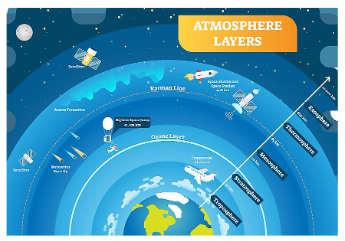
Appointment of New CBI Director
Syllabus: GS2/ Indian Constitution, Parliament & State Legislatures
In News
- Recently, the 1986-batch, Karnataka cadre Indian Police Service (IPS) officer Praveen Sood has been appointed the head of the Central Bureau of Investigation (CBI).
Appointment of the CBI director
- The process of appointment was established by the Supreme Court’s Vineet Narain judgement (1997), and the changes made to The Delhi Special Police Establishment (DSPE) Act, 1946 by The Lokpal and Lokayuktas Act, 2013.
- The Lokpal Act 2013 prescribed that the CBI director shall be appointed on the recommendation of a committee comprising the
- Prime Minister,
- Leader of the Opposition in the Lok Sabha and
- Chief Justice of India or a judge of the Supreme Court nominated by him.
- The Lokpal Act 2013 prescribed that the CBI director shall be appointed on the recommendation of a committee comprising the
About Central Bureau of Investigation (CBI)
- About:
- It is the premier investigating police agency in India.
- It is an elite force playing a major role in preservation of values in public life and in ensuring the health of the national economy.
- The Supreme Court, the High Courts, the Parliament and the public, holds CBI as an organisation in high esteem.
- Origin:
- It has its origin in the Special Police Establishment set up in 1941 to probe bribery and corruption during World War II.
- It was set up by a resolution of the Ministry of Home Affairs in 1963 after Santhanam committee recommendation.
- Ministry:
- It functions under the Department of Personnel, Ministry of Personnel, Pension & Public Grievances, Government of India.
- Functions:
- CBI was established by the Government of India with a view to investigate serious crimes related to the defence of India, corruption in high places, serious fraud, cheating, and embezzlement and social crime, particularly hoarding, black marketing, and profiteering in essential commodities, having all-India and inter-state ramifications.
- It is also the nodal police agency in India that coordinates investigations on behalf of Interpol member countries.
- Jurisdiction:
- Section 6 of the DPSE Act authorises the central government to direct CBI to probe a case within the jurisdiction of any state on the recommendation of the concerned state government.
- The courts can also order a CBI probe, and even monitor the progress of investigation.
- CBI can suo-moto take up investigation of offences only in the Union Territories.
- Section 6 of the DPSE Act authorises the central government to direct CBI to probe a case within the jurisdiction of any state on the recommendation of the concerned state government.
- Conviction rate:
- According to the Central Vigilance Commission (CVC) annual report, its conviction rate is as high as 65 to 70%, which is comparable to the best investigation agencies in the world.
Issues & criticisms
- Lack of General Consent:
- The conduct or continuance of investigation into offences committed within the territory of a state, consent of the state is required which most of the time is delayed or even denied.
- General Consent:
- CBI needs consent of a state to probe offences in the state’s jurisdiction, a general consent is given to the agency so that consent is not required for every individual case.
- Withdrawal of consent means CBI cannot investigate even a central government employee stationed in a state without the consent of the state government.
- General Consent:
- Many states, including West Bengal, Bihar, Chhattisgarh, Rajasthan, Punjab and Meghalaya, have withdrawn general consent for the Central Bureau of Investigation (CBI) to probe cases in their jurisdiction.
- At the time of withdrawing consent, all states alleged that the central government was using the CBI to unfairly target the opposition.
- The conduct or continuance of investigation into offences committed within the territory of a state, consent of the state is required which most of the time is delayed or even denied.
- Administrative issues:
- Lack of infrastructure, sufficient manpower and modern equipment;
- In-human conditions, especially at the lowest rung;
- Questionable methods of procuring evidence;
- Officers failing to abide by the rule book; and
- Lack of accountability of erring officers.
- Political Issues:
- In May 2013, as multiple corruption scandals dogged the UPA government, the Supreme Court made an observation about the Central Bureau of Investigation (CBI) that has stuck to the agency ever since.
- A Bench headed by Justice R M Lodha described the CBI as “a caged parrot speaking in its master’s voice” (Politicisation of CBI).
- The observation was made in the context of government interference in the functioning of the CBI in its investigation of the coal blocks allocation cases.
- Transparency Issues:
- The CBI is exempted from the purview of the Right to Information (RTI) Act, 2005.
- Overlapping Functions:
- There is an overlap in jurisdictions of CVC, CBI and Lokpal in certain cases leading to problems.
Suggestions & Way ahead
- Creation of Independent umbrella institution:
- There is an immediate need for the creation of an independent umbrella institution, so as to bring various central agencies like the CBI, Enforcement Directorate and the Serious Fraud Investigation Office under one roof.
- This body is required to be created under a statute, clearly defining its powers, functions and jurisdictions.
- Independence:
- The organisation should be headed by an independent and impartial authority, appointed by a committee akin to the one which appointed the CBI Director.
- Its head could be assisted by deputies having specialisation in different domains.
- Relationship between the State and Central agencies:
- There should be a harmonious relationship between the State and Central agencies and collaboration was the key, given that the goal of all those organisations was to secure justice.
- Upgradation of knowledge:
- There is a need for regular upgradation of knowledge, deployment of state-of-the-art technology, and international exchange programmes to learn the best practices.
- The role, jurisdiction and legal powers of the CBI need to be clearly laid down.
Source:
Long COVID
Syllabus: GS3/GS2/Science and Technology/Health
In News
Post COVID-19 Pandemic there is a lingering problem called long COVID that requires greater attention.
What is Long COVID
- It is defined as the continuation or development of new symptoms 3 months after the initial SARS-CoV-2 infection, with these symptoms lasting for at least 2 months with no other explanation.
Symptoms
- While common symptoms of long COVID can include fatigue, shortness of breath and cognitive dysfunction over 200 different symptoms have been reported that can have an impact on everyday functioning.
Precaution from long COVID
- Protection from long COVID means protecting yourself and others from COVID-19 infection in the first place.
- WHO recommends a number of simple, proven measures to help do this:
- Taking up offers of COVID-19 vaccines/boosters,
- Wearing well-fitted masks,
- cleaning hands regularly,
- catching coughs and sneezes,
- ensuring indoor spaces are well ventilated.
Vulnerable Group
- Research is ongoing to determine why only some individuals develop long COVID. Some studies have found that it is more common in women, but it has not been conclusively linked to any specific age group or the severity of the initial infection.
- Initially, long COVID was thought to be an autoimmune phenomenon, and some believe it is due to persistence of the virus in remote parts of the body, such as the gut. Reactivation of other viruses in the body is also implicated.
- There is evidence of an abnormal immune response in long COVID, but it is not clear what drives this response or what can be done to alleviate it.
Diagnosis
- For COVID-19, death is a frequently discussed hard outcome measure. However, long COVID is a relatively soft outcome because its onset is more insidious and its diagnosis is less certain.
- Many people experiencing long COVID do not rush to the doctor, and among those who do, a diagnosis is seldom made. Frequently, such people are ignored as ‘psychological’ or ‘anxiety-related’.
- Unfortunately, there are no diagnostic tests such as X-rays, CT scans, or blood tests to confirm long COVID. Therefore, a sizeable number of patients with long COVID go undetected and either suffer in silence or end up being victims of those who peddle miracle cures on social media.
Impact
- Studies show that around 10–20% of people infected by SARS-CoV-2 may go on to develop symptoms that can be diagnosed as long COVID.
- Although exact numbers of those living with the condition are uncertain, it is believed that more than 17 million people across the WHO European Region may have experienced it during the first two years of the pandemic (2020/21).
- A study of long COVID from AIIMS, Delhi during the first wave reported its incidence to be as high as 10%.
- More recent studies estimate the true incidence to be around 5%, which implies that one out of 20 patients with COVID-19 go on to develop long COVID.
- Across the world, millions continue to suffer from long COVID, and a study last year by the Atlanta-based CDC found that nearly one-fifth of people in the U.S. who had the disease in the last two years continued to suffer from long COVID.
Way Ahead
- Recognising the existence of long COVID and continuing to implement regionally appropriate mitigation measures when the situation so demands will help in reducing the negative impact of the pandemic on global health and productivity.
Source: TH
Mitochondrial Replacement Therapy (MRT)
Syllabus: GS3/ Science & Technology
In News
- After the UK, Australia became the second country to allow Mitochondrial Replacement Therapy (MRT). In 8 years less than 5 children are born using this technique in the UK. In India it has not been explored much.
What is Mitochondrial Replacement Therapy (MRT)?
- MRT is an in-vitro fertilization technique designed to prevent women who are carriers of mitochondrial diseases from passing on these heritable genetic diseases to their children. MRT involves alterations to the egg or embryo prior to implantation, and this means that it falls under the broad class of gene therapies that are considered germline therapies.
|
In-Vitro fertilization (IVF)
Mitochondrial Diseases Mitochondrial disease, or mitochondrial disorder, refers to a group of disorders that affect the mitochondria also known as powerhouse of the cell. Mitochondria have their own DNA called mitochondrial DNA, or mDNA. Mutations in this mDNA or mutations in nuclear DNA (DNA found in the nucleus of a cell) can cause mitochondrial disorder. Environmental toxins can also trigger mitochondrial disease. Symptoms of Mitochondrial Diseases are:
|
How does MRT help?
- All humans have two types of DNA: nuclear and mitochondrial. Each cell contains one complete set of nuclear DNA but there are multiple copies of mDNA present within the cell.
- Fertilization is the process by which the male and female sex cells, called gametes, combine to form an embryo, also called a zygote.
- The egg or oocyte is the gamete that provides all of the cell cytoplasm and organelles to the combined zygote once fertilization is complete since mitochondria from sperm cell is eliminated during early embryo development.
- This means that the mother provides all of the mitochondria and mDNA, and so mitochondrial diseases can only be passed down from the mother.
- Thus MRT focuses on the removal of mutated mDNA from the fertilized zygote and develops in a healthy environment.
How is MRT performed?
- There are two processes by which MRT can be performed:
- Maternal spindle fiber transfer (MST)
- Pronuclear transfer (PNT)
- Both processes use a donor egg who has normal mDNA.

|
Three Parent Baby
|
Issues with MRT
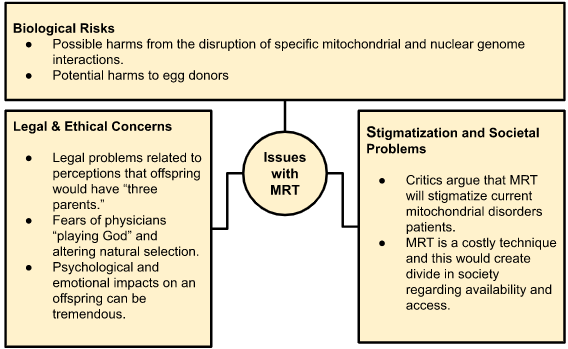
Laws and Regulation of MRT
- Britain:
- In 2015, Britain’s Parliament voted to pass an amendment to the Human Fertilisation and Embryology Act, 2008 to allow MRT.
- Approval is given on a case-by-case basis by the U. K.’s Human Fertilisation and Embryology Authority (HFEA).
- USA:
- The clinical use of MRT in the United States falls within Food and Drug Administration’s (FDA) regulatory authority.
- Since December 2015, Congress has included provisions that prohibit FDA from accepting applications for clinical research using MRT.
- Therefore, clinical research using MRT in humans cannot legally proceed in the United States.
Conclusion
- There is a need to assess the potential risks against the potential gains and then make a balanced approach for adopting MRT.
- Appropriate informed consent should be obtained from the donor mother before going forward with MRT.
- Ethical and legal concerns can be addressed through proper legislation.
- Better research in genetic diseases should be promoted so as to remove inherent vulnerabilities in it.
Source: TH
Gaganyaan
Syllabus: GS3/ Science & Technology, Space
In News
- Indigenously developed parachutes for the safe return of the capsule that will carry astronauts under the proposed Gaganyaan programme are being tested by ISRO.
- It is developed by The Aerial Delivery Research and Development Establishment (ADRDE), the Agra-based laboratory under the Defence Research and Development Organisation (DRDO).
What is Gaganyaan Mission?
- Gaganyaan Mission of ISRO aims to achieve human spaceflight capability by launching a crew of 3 members to Low Earth Orbit of 400 km bringing them back safely to earth, by landing in Indian sea waters.
- India will be the fourth nation to achieve this feat after Russia, USA and China.
|
Low Earth Orbit
Karman Line
|
Mission Specifics
- The uncrewed ‘G1’ mission is targeted to be launched in the last quarter of 2023 followed by the second uncrewed ‘G2’ mission in the second quarter of 2024, before the final human space flight ‘H1’ mission in the fourth quarter of 2024.
- Various tests to check Technology Preparedness Levels for safety of crew are planned. These demonstrator missions include
- Integrated Air Drop Test (IADT),
- Pad Abort Test (PAT) and
- Test Vehicle (TV) flights
- LVM3 rocket of ISRO, is identified as the launch vehicle for Gaganyaan mission. Its parts are re-configured to meet human rating requirements and changed into Human Rated LVM3 (HLVM3). LVM3 consists of solid stage, liquid stage and cryogenic stage.
- HLVM3 consists of Crew Escape System (CES) powered by a set of quick acting, high burn rate solid motors which ensures that Crew Module along with crew is taken to a safe distance in case of any emergency either at launch pad or during ascent phase.
- Orbital Module (OM) that will be Orbiting Earth comprises Crew Module (CM) and Service Module (SM).
- CM is the habitable space with Earth like environment in space for the crew. I
- SM will be used for providing necessary support to CM while in orbit.
Achievements So far:
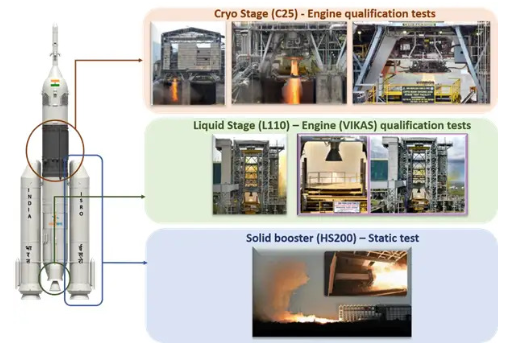
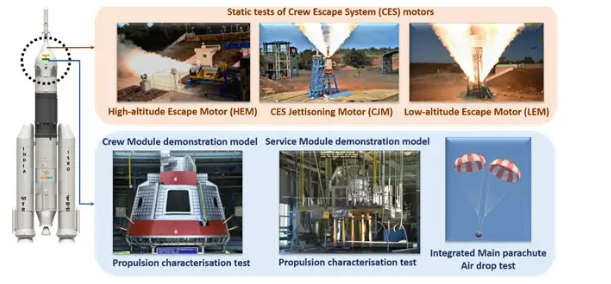
Importance of Gaganyaan Mission
- Progress towards a sustained and affordable exploration of the solar system and beyond.
- Advanced technology capability for undertaking human space exploration, sample return missions and scientific exploration.
- Scope for employment generation and human resource development in advanced science and R&D activities.
- It will strengthen international partnerships and global security through the sharing of challenging and peaceful goals.
Challenges
- Hostile space environment with a lack of gravity and atmosphere and danger of radiation.
- Transition from one gravity field to another affects hand-eye and head-eye coordination leading to orientation-loss, vision, muscle strength, aerobic capacity, etc.
- There are two choices for an artificial atmosphere, either an Earth-like mixture of oxygen in inert gas or pure oxygen. A pure or concentrated oxygen atmosphere is toxic and has fire risk, especially in ground operations.
Other ISRO Missions
|
Mission |
Tentative Target |
|
Aditya L1 |
Mid 2023 (expected) |
|
Chandrayaan 3 |
June 2023 |
|
Shukrayaan 1 |
2024 |
|
Mangalyaan 2 |
2024 |
Way Forward
- The next step after this mission will focus towards achieving capability for a sustained human presence in space.
- India could look forward to establishing a Space Station which will be a platform for conducting scientific and industrial research in myriad areas of fundamental, applied and engineering sciences.
Source: TH
Kaliningrad
GS 2 / International
In News
- The Polish government has advised that Russia’s exclave of Kaliningrad should be renamed as Królewiec. Russia said Poland’s decision was “a hostile act”.
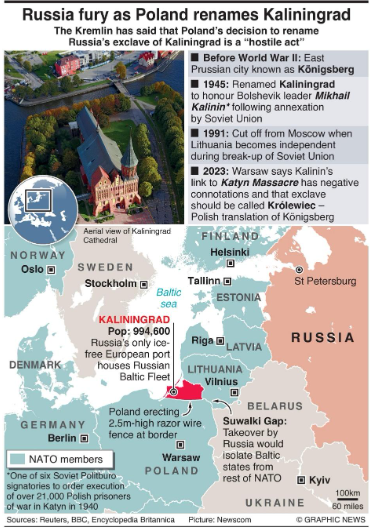
Geography
- Ownership: Kaliningrad Oblast is the westernmost federal subject of Russia.
- Borders: It is a semi-exclave bordered by Poland, Lithuania and the Baltic Sea.
- Key cities: Its largest city is the ‘City of Kaliningrad’. It also houses the port city of Baltiysk on the Baltic Sea.
- Lagoons: The Curonian Lagoon (shared with Lithuania) and the Vistula Lagoon (shared with Poland) are its notable geographical features.
- Rivers: The oblast’s largest river is the Pregolya. The end of the river Neman forms part of the Lithuania–Russia border.
- Significance: Kaliningrad is strategically important to Russia because it houses the Russian Baltic Fleet at the port of Baltiysk and is Russia’s only ice-free European ports.
|
Exclave vs Enclave
|
History
- The territory was formerly the northern part of the Prussian province of East Prussia; the remaining southern part of the province is today part of Poland.
- With the defeat of Nazi Germany in World War II, the territory was annexed by the Soviet Union.
- Under the Potsdam Agreement of 1945 (between three of the Allies of World War II: the United Kingdom, the United States, and the Soviet Union), the territory officially became part of the Russian SFSR of the Soviet Union.
History of Its name; Objections by Poland
- Kaliningrad was known by the German name of Königsberg. After the second world war, the Soviet Union renamed it to honour politician Mikhail Kalinin.
- Mikhail Kalinin was one of six Soviet Politburo signatories to the order to execute more than 21,000 Polish prisoners of war in the forests of Katyn and elsewhere in 1940.
- Poland says that Kalinin’s connection to the Katyn Massacre has negative connotations and that the exclave should be called Królewiec – the Polish translation of Königsberg.
Source: HT
Pratima Murthy Committee
Syllabus: GS2/Health
In News
- Insurance Regulatory and Development Authority (IRDAI) has constituted a five-member expert committee comprising medical experts and insurers for advice on matters related to mental health and insurance.
About the Committee
- The panel, with a two-year tenure, comes in the backdrop of mental health being identified as an important area requiring attention for insurance coverage.
- The National Institute of Mental Health and Neurosciences (NIMHANS) Director Pratima Murthy will chair the committee.
- The committee will be providing advice and inputs on existing coverage and those to be offered for mental illnesses.
- It will also guide on the terminology and concept from a medical domain perspective, and aspects pertaining to mental illnesses from an insurance perspective.
- A holistic examination of aspects involved such as types of conditions, treatments from an insurance perspective is necessary when dealing with products designed to cover mental illnesses and other related aspects.
Insurance covers for the Surrogate Mother
- IRDAI also advised all insurers to comply with the provisions pertaining to insurance covers for the surrogate mother and oocyte donor under the Surrogacy (Regulation) Act, 2021, and Assisted Reproductive Technology (ART) Act, 2021.
- Under the Surrogacy (Regulation) Act the intending woman or couple should purchase a three-year health insurance for the surrogate mother. The cover should be for an amount sufficient to cover all expenses for all complications arising out of pregnancy and also covering postpartum delivery complications.
- The ART Act, 2021, has stipulated insurance coverage for 12 months in favour of the oocyte donor by the commissioning couple or woman, for an amount sufficient to cover all expenses for complications arising due to oocyte retrieval.
About Insurance Regulatory and Development Authority (IRDAI)
- It is a statutory body formed under an Act of Parliament, i.e., Insurance Regulatory and Development Authority Act, 1999 (IRDA Act, 1999) for overall supervision and development of the Insurance sector in India.
- Governing Acts: The powers and functions of the Authority are laid down in the IRDA Act, 1999 and Insurance Act, 1938.
- The Insurance Act, 1938 is the principal Act governing the Insurance sector in India. It provides the powers to IRDAI to frame regulations which lay down the regulatory framework for supervision of the entities operating in the Insurance sector. Section 14 of the IRDA Act, 1999 specifies the Duties, Powers and Functions of the Authority.
- Key Objectives: protecting the interest of policyholders, speedy and orderly growth of insurance industry, speedy settlement of genuine claims, effective grievance redressal mechanism, promoting fairness, transparency and orderly conduct in financial markets dealing with insurance, prudential regulation while ensuring the financial security of the Insurance market.
Source: TH
Storm Shadow Missiles
GS 3 / Security; GS 2 / International
In News
- Britain has become the first western country to provide Ukraine with the long-range Storm Shadow cruise missiles.
About
- Manufacturer: It is manufactured by MBDA, a European multinational developer and manufacturer of missiles based in France.
- Usage in past: The missile has been operated by both British and French air forces and has been used previously in the Gulf, Iraq and Libya.
- Features: Storm Shadow is a long-ranged, air-launched, conventionally armed, deep-strike missile. It has a range of “in excess of 250km”, which is significantly further than the high-precision US Himars rocket launchers currently used by Ukraine.
- BROACH: It is armed with a penetrating warhead capable of destroying hardened and buried targets from long range. The missile features the BROACH (Bomb Royal Ordnance Augmented CHarge) warhead — a high-technology warhead, which first cuts the surface of the target, penetrates into it and then explodes.
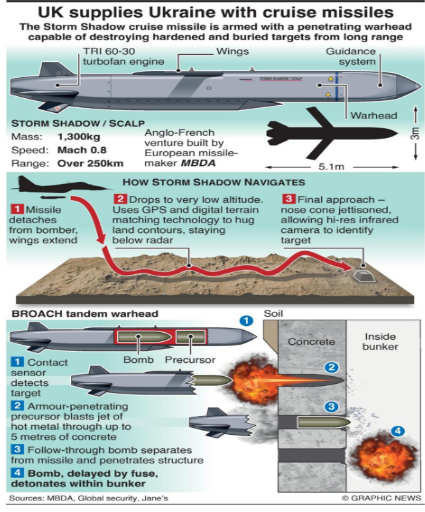
Significance for Ukraine
- It will give Ukrainian forces the ability to strike Russian military targets located well behind the front lines — especially in Crimea, which Russia illegally occupied in 2014.
- The Ukrainians could use Storm Shadow to destroy the Kerch Bridge that connects Crimea to the Russian mainland.
Source: IE
Scalloped Hammerhead Shark (Spjyrna Lewini)
GS 3 / Environment
In News
- A study published in the journal Science shows that scalloped hammerhead sharks remain warm while diving into the ocean’s frigid depths to hunt for food. They maintain their body temperature by closing their gills, essentially holding their breath.
- This strategy has never been observed before and distinguishes them from high-performance fish such as great white sharks or Atlantic bluefin tuna that use different strategies to tolerate extreme cold.
Hammerhead shark
- Family: The hammerhead sharks are a group of sharks that form the family Sphyrnidae.
- List of Species include: Winghead shark, Scalloped bonnethead, Scalloped hammerhead, Carolina hammerhead, Scoophead, Great hammerhead, Bonnethead, Smalleye hammerhead and Smooth hammerhead.
- Name: They are named as their heads are flattened and laterally extended into a “hammer” shape called a cephalofoil. This shape differs between species; examples are: a distinct T-shape in the great hammerhead and a rounded head with a central notch in the scalloped hammerhead.
- Distribution: Hammerheads are found worldwide in warmer waters along coastlines and continental shelves.
Scalloped hammerhead shark
- Scientific Name: Sphyrna lewini.
- IUCN Red List Status: Globally Endangered.
- Threats: Its population is declining because of overfishing, driven by the high economic value of its fins and the consumption of its meat.
- Distribution: It is a circum-global shark species that is found worldwide in coastal warm temperate and tropical seas of the Atlantic, Indian, and Pacific oceans.
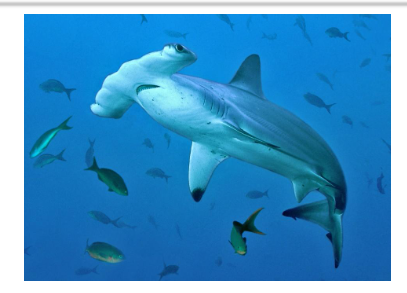
Source: IE
Milkweed Butterflies
Syllabus :GS 3/Species In News
In News
- A recent study by a team of researchers shed light on the migration patterns of Milkweed butterflies in southern India.
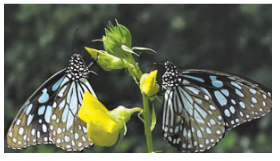
About Milkweed butterflies
- The Milkweed butterfly is any of a group of butterflies in the brush-footed butterfly family, Nymphalidae .
- The majority of species are found in both Old and New World tropics.
- However, some well-known members such as the monarch butterfly and the queen butterfly live in temperate regions.
- Description: The large, colourful adults have long, usually brownish or orange wings marked by black-and-white patterns. The first pair of legs are small and not used for walking.
- They fly slowly and deliberately, and some, such as the monarch butterfly, migrate great distances.
- Diet: They feed chiefly on milkweed and sometimes on nightshade.
- Migration: Millions of Milkweed butterflies undertake a migration between the Eastern and Western Ghats in southern India, seeking refuge from the harsh summer.
- A recent study found that the dominant species involved in the migration, the Dark blue tiger and Double-branded crow, are not found breeding in the mid and high-altitude evergreen and semi-evergreen forests of the Western Ghats.
- However, further studies are needed to confirm the finding
- Importance: The migration of Milkweed butterflies also plays a vital ecological role during the migration. As pollinators, their movements can impact entire ecosystems.
- Threats: Their migration is threatened by changes in land use, habitat destruction and climate change.
- Suggestions: By unravelling the mysteries of their migration, we can help protect these beautiful creatures and the ecosystems they inhabit
- Studying their migration patterns and feeding habits can impart the interconnectedness of plant and animal life.
- The study has the potential to contribute to the conservation of these butterflies.
Source: TH
4th Positive Indigenisation List (PIL)
Syllabus : GS 3/Defence
In News
- Defence Minister Rajnath Singh has approved the 4th Positive Indigenisation List (PIL) of 928 with an import substitution value worth Rs 715 crore.
About the list
- The items that figure in the PIL will only be procured from the indigenous industry after the timelines indicated in the list available on the Srijan portal.
- This fourth list is in continuation to the previous three PILs involving Line Replacement Units (LRUs) / Sub-systems / Assemblies /Sub-assemblies/ Spares & Components which were published in December 2021, March 2022 and August 2022 respectively.
- The DPSUs will undertake indigenisation of these items through different routes under the ‘Make’ category and in-house development through the capabilities of MSMEs and private Indian industry, thereby providing impetus to the growth in the economy, enhanced investment in defence and reduction in import dependence of DPSUs.
Aims and Objectives
- To promote ‘Aatmanirbharta’ in defence & minimise imports by Defence Public Sector Undertakings (DPSUs),
- In addition, this will augment the design capabilities of the domestic defence industry by involving academia and research institutions.
- The objective of the indigenisation list is to reduce imports by DPSUs in the defence sector.
Future Outlook
- The Indian armed forces will be spending roughly $130 billion towards the acquisition of capital goods during the upcoming five years.
- The government is looking to minimize its reliance on foreign military equipment and has opted to promote domestic defence manufacturing.
- To this end, the defence ministry has set a target of achieving a turnover of $25 billion (equivalent to ?1.75 lakh crore) in defence manufacturing within the next five years.
- This goal includes an objective of exporting $5 billion worth of military hardware.
|
Do you Know?
|
Source: TH
EXERCISE SAMUDRA SHAKTI – 23
Syllabus: GS3/Defence, Internal Security
In News
4th edition of India-Indonesia Bilateral exercise Samudra Shakti-23 is being conducted from 14th May.
About the Exercise
- In pursuance of India’s Act East Policy, Exercise ‘Samudra Shakti’ was conceived in 2018 as a bilateral maritime exercise between India and Indonesia.
Bilateral exercises between India and Indonesia
- Exercise Garuda Shakti is a bilateral joint special force exercise.
- CORPAT (India-Indonesia Coordinated Patrol) is a naval exercise.
- Ex KOMODO is a multilateral Naval Exercise by the Indonesian Navy. It is annually held between the Indian Ocean and the Pacific Ocean.
Source: PIB

